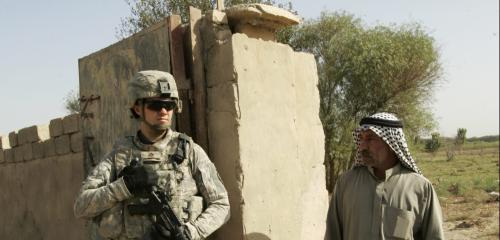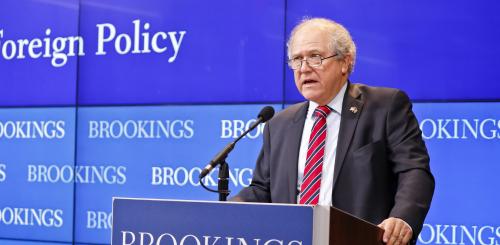In the last decade, government assistance to Afghanistan, Iraq, and Pakistan (the AIP countries) has dominated U.S. aid efforts. We’ve learned that it’s difficult to provide aid to dangerous places.
Iraq: Enthusiastic and unprepared
When I went to Mosul as the first leader of the first Provincial Reconstruction Team (PRT) in 2006, we knew that the post-conflict situation would not correct itself. Unlike in Central Europe in 1989—when crowds protested yet returned to work the next day—crowds in Iraq instead looted ministries after the liberation. Once it became clear in 2004 and 2005 that Iraq was falling into disarray, the United States sought to impose a well-ordered society. The U.S. military initially took the lead.
In Baghdad, the embassy created the Iraqi Reconstruction Management Office (IRMO) in 2004, which supervised the PRTs (created in 2005)—Mosul was the first of four. IRMO consisted of contractors who were long on advice and short on funds. That advice responded to bureaucratic need, rather than strategic goals. So when I arrived in Mosul in January 2006, I was given a set of slides describing the Defense Department’s budget and the embassy’s structure, but very little to do with the problems of Ninewa, the province for which my PRT was responsible.
I created structures in the PRT based not on provincial needs but on who was there. I had a staff of 50, half of them U.S. Army Civil Affairs officers—few of them experts, but all were creative and enthusiastic. An officer from the Army Corps of Engineers oversaw contracting, a former manager of a regional airport in North Carolina helped with infrastructure projects, and a public prosecutor from Texas (provided by the Department of Justice) served as our rule of law expert. There were a handful of diplomats, with a sole USAID officer.
We quickly created lines of operation (LOOs, in military parlance) for governance, rule of law, infrastructure, and economic development. In rule of law, the prosecutor worked with judges and local prosecutors, as well as worked closely with the U.S. military’s extensive police-training programs, run out of Baghdad. We created an infrastructure development office, relying on the expertise of the engineer, the airport expert, and USAID.
After the destruction of the Golden Mosque in Samarra in February of 2006, the security situation became dire. Just going “over the wire” to visit local leaders was difficult.
Our own bureaucratic structure prevented understanding our surroundings.
Our priority quickly became security, rather than development. The U.S. military had created, in 2003, a program called Commander’s Emergency Response Program, which provided infantry officers with cash to achieve tactical goals. A captain could bribe a sheikh to build a road, for instance—therefore providing jobs and repairing infrastructure. While the U.S. military leadership in Mosul tried to make tactical military actions consistent with strategic PRT efforts, it was a challenge to simultaneously deal with mortar fire and brutal battles in towns like Tal Afar on the one hand, and development projects on the other.
Our own bureaucratic structure prevented understanding our surroundings. PRT members served for only a few months, thus rarely achieving deep knowledge of tasks and context. We tried to create a constitutional framework, where political leaders, police, courts, business people, and citizens would have institutions—familiar to us—that would function to our satisfaction. But that didn’t necessarily work in a traumatized city split between Sunni Arabs and Kurds, in a diverse province of Shiite, Christian, Yazidi, Turkmen, and countless other ethnicities.
Pakistan: More is better?
I arrived in Pakistan in 2010, at a time of great hope for U.S.-Pakistani relations. Elections had been held in 2008, and optimists in Islamabad and Washington believed that a new relationship might emerge. Legislation sponsored by John Kerry, Richard Lugar, and Howard Berman tried to create a long-term basis for civilian rule and economic prosperity in Pakistan: Starting in 2009, it provided $1.5 billion annually for five years to bolster the new civilian leadership.
The embassy expanded massively. USAID had dedicated professionals and the most talented local Pakistani staff in the mission. But aid workers were assigned for short missions (a year or less), and few had an understanding of local culture. All, meanwhile, were under enormous pressure to ensure proper oversight as well as a proper “burn rate.” That is, it mattered how quickly the money was spent, and how completely it was reported to Congress. Many assistance workers found themselves, to their horror, watching Washington more closely than Pakistan.
Pakistani leaders sought help with the energy sector, education, and job creation. But American officials, flush with assistance money, initially engaged in what I called “drive-by grant-giving,” rewarding a worthy NGO or a local charter school in a one-off show of support.
We measured our commitment to Pakistan by how much we spent rather than assessing our impact.
The real world also interfered: The disastrous floods of fall 2010 destroyed crops, homes, and claimed hundreds of victims. The United States reprogrammed $500 million to support flood relief, with some success: There was no famine in 2011. But that meant that many worthy long-term projects were terminated while still in the (long) USAID pipeline.
In 2011, U.S. leaders decided to focus on education, energy efficiency, job creation, public health, and special projects in the tribal areas as priorities. It’s one thing to define a task, quite another to apply it to a country where security considerations prevented most USAID workers from visiting projects. Thus, in education, we did what we knew how to do—build schools—but often the schools were never used. Teachers weren’t trained, and curriculum reform stalled. USAID officials oversaw budgets rather than projects. We measured our commitment to Pakistan by how much we spent rather than assessing our impact.
Better next time
What are lessons learned from all this?
- When there is no security, we should stick to humanitarian aid and immediate reconstruction, rather than launch more ambitious development projects.
- Local knowledge is key. USAID should train officers for the field, not to oversee budgets and write grant proposals.
- Only joint civilian-military teams should disburse funds from the Commander’s Emergency Response Program, to align tactical and strategic goals.
Above all, U.S. civilian and military personnel working on large-scale reconstruction projects overseas need to balance the needs of Washington with an understanding of on-the-ground reality. Striking this balance is essential to having a lasting impact.
This post is part of a Brookings Institution seminar series on Reconstituting Local Orders, directed by Vanda Felbab-Brown, Shadi Hamid, and Harold Trinkunas.






Commentary
Better next time? Tales from the American aid experiences in Iraq and Pakistan
January 14, 2016